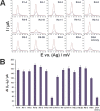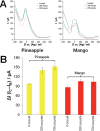Detection of Cryptosporidium parvum Oocysts on Fresh Produce Using DNA Aptamers
- PMID: 26334529
- PMCID: PMC4559477
- DOI: 10.1371/journal.pone.0137455
Detection of Cryptosporidium parvum Oocysts on Fresh Produce Using DNA Aptamers
Abstract
There are currently no standard methods for the detection of Cryptosporidium spp., or other protozoan parasites, in foods, and existing methods are often inadequate, with low and variable recovery efficiencies. Food testing is difficult due to the low concentrations of parasites, the difficulty in eluting parasites from some foods, the lack of enrichment methods, and the presence of PCR inhibitors. The main objectives of the present study were to obtain DNA aptamers binding to the oocyst wall of C. parvum, and to use the aptamers to detect the presence of this parasite in foods. DNA aptamers were selected against C. parvum oocysts using SELEX (Systematic Evolution of Ligands by EXponential enrichment). Ten rounds of selection led to the discovery of 14 aptamer clones with high affinities for C. parvum oocysts. For detecting parasite-bound aptamers, a simple electrochemical sensor was employed, which used a gold nanoparticle-modified screen-printed carbon electrode. This aptasensor was fabricated by self-assembling a hybrid of a thiolated ssDNA primer and the anti- C. parvum aptamer. Square wave voltammetry was employed to quantitate C. parvum in the range of 150 to 800 oocysts, with a detection limit of approximately 100 oocysts. The high sensitivity and specificity of the developed aptasensor suggests that this novel method is very promising for the detection and identification of C. parvum oocysts on spiked fresh fruits, as compared to conventional methods such as microscopy and PCR.
Conflict of interest statement
Figures






Similar articles
-
Development and application of DNA-aptamer-coupled magnetic beads and aptasensors for the detection of Cryptosporidium parvum oocysts in drinking and recreational water resources.Can J Microbiol. 2019 Nov;65(11):851-857. doi: 10.1139/cjm-2019-0153. Epub 2019 Aug 12. Can J Microbiol. 2019. PMID: 31404505
-
Evaluation of two DNA template preparation methods for post-immunomagnetic separation detection of Cryptosporidium parvum in foods and beverages by PCR.Appl Environ Microbiol. 2007 Nov;73(22):7474-6. doi: 10.1128/AEM.01652-07. Epub 2007 Sep 21. Appl Environ Microbiol. 2007. PMID: 17890339 Free PMC article.
-
An immunomagnetic separation-real-time PCR method for quantification of Cryptosporidium parvum in water samples.J Microbiol Methods. 2003 Jul;54(1):29-36. doi: 10.1016/s0167-7012(03)00005-8. J Microbiol Methods. 2003. PMID: 12732419
-
Biology, persistence and detection of Cryptosporidium parvum and Cryptosporidium hominis oocyst.Water Res. 2004 Feb;38(4):818-62. doi: 10.1016/j.watres.2003.10.012. Water Res. 2004. PMID: 14769405 Review.
-
Cryptosporidium parvum and Cyclospora cayetanensis: a review of laboratory methods for detection of these waterborne parasites.J Microbiol Methods. 2002 May;49(3):209-24. doi: 10.1016/s0167-7012(02)00007-6. J Microbiol Methods. 2002. PMID: 11869786 Review.
Cited by
-
Development and synthesis of DNA-based label-free electrochemical biosensor for detection of Enterocytozoon bieneusi using screen-printed gold electrode.BMC Chem. 2025 Jul 2;19(1):184. doi: 10.1186/s13065-025-01547-6. BMC Chem. 2025. PMID: 40604918 Free PMC article.
-
Electrochemical Biosensors for Pathogen Detection: An Updated Review.Biosensors (Basel). 2022 Oct 26;12(11):927. doi: 10.3390/bios12110927. Biosensors (Basel). 2022. PMID: 36354437 Free PMC article. Review.
-
On-chip-based electrochemical biosensor for the sensitive and label-free detection of Cryptosporidium.Sci Rep. 2022 Apr 28;12(1):6957. doi: 10.1038/s41598-022-10765-0. Sci Rep. 2022. PMID: 35484282 Free PMC article.
-
Recent Advances in Aptamer Discovery and Applications.Molecules. 2019 Mar 7;24(5):941. doi: 10.3390/molecules24050941. Molecules. 2019. PMID: 30866536 Free PMC article. Review.
-
Oligonucleotide aptamers for pathogen detection and infectious disease control.Theranostics. 2021 Aug 27;11(18):9133-9161. doi: 10.7150/thno.61804. eCollection 2021. Theranostics. 2021. PMID: 34522231 Free PMC article. Review.
References
Publication types
MeSH terms
Substances
LinkOut - more resources
Full Text Sources
Other Literature Sources
Miscellaneous

